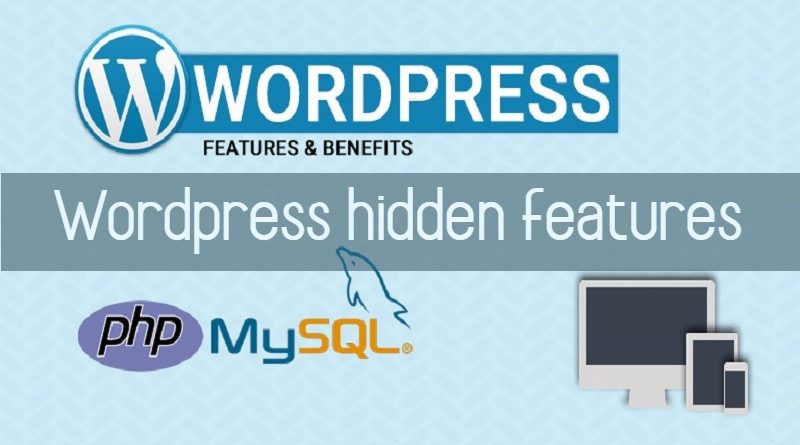Top 8 Hidden Features of WordPress
There are some features of WordPress you may not know about. These features were discussed at WordCamp in Toronto, here are the main ones.
di Antonio Lamorgese
There are some hidden features of WordPress features that you may not have heard of before. These features were highlighted and discussed at the WordCamp in Toronto, and the experts focused mainly on some of these lesser-known features.
The WordPress developers did not intentionally hide these features. It is just that the user is not aware of the fact that the CMS offers shortcuts or extraordinary features that can facilitate not only the drafting of a post, but also the administrative management of the blog itself.
Let’s take a look at eight different features you may not have heard of before and how they can help you dramatically improve your work in WordPress.
Table of contents...
1. Screen options

Screen options can extend the functionality of some administration pages. Within the admin section, scroll down to the top right corner and you will find the Screen Options just below the “Howdy ‘your name'” message.

Using Screen Options gives you the ability to enable and disable various features of specific admin pages, including pages, posts, comments, widgets, menus, plug-ins, and more. Take a look to see how much you can extend or minimize the functionality of your WordPress workspace.
2. Help options
Located right next to the screen options, you can use the Help before you google the question in question. Depending on which admin page you are on, the guidelines in the guide will differ. For example, if you are on the post editor page, the help options will be as follows:

As you can see, the help function is a great way to delve into some administration pages. You may be learning things you didn’t know before or that wouldn’t be so easy to find elsewhere.
3. Option post and option page
If you’re new to blogging on WordPress, you may have overlooked the Post Options and Page Options, which can be found in the right panel of your post editor or page editor. Here are some specific features you should be aware of:
• You can use Visibility to make your posts public or available only to a specific audience (they will need a password to access them).
• If you create a sticky post, it will appear first, even after creating new blog posts.
• You can also change the publication date of a post. Changing the publication of a blog post will change its order.
• If you happen to need to go back to a previous version of the post (for example, the internet loses connection or you lose your job), use Track Changes. Each time you save a draft, it will be revised. (If you are on the WP Engine platform, see here for how to enable / disable revisions.)
4. Editor options
Have you ever wondered what some buttons do within the post editor? Some symbols are cryptic at first glance, but here’s a visual explanation of those lesser-known features within the editor:

Also, if you are HTML savvy, you can make changes to your post in the text editing mode. For example, if you want to embed a video, this is where you will paste the code.

5. Quick edit
Are you in a hurry to edit a post? While quick edit doesn’t necessarily allow you to edit the copy of a post, you can make changes to certain aspects, including title, slug, date, author, categories, and so on.

Using Quick Edit in conjunction with Custom Screen Options will allow you to make bulk edits to posts faster.
6. Secret “hidden” options panel …
You can access this secret point by going to http://yoursite.com/wp-admin/options.php. But be careful! Making changes here can get you in trouble. Make changes only if it’s your last resort.
7. Various shortcuts
In addition to accessing the keyboard shortcuts within the post editor menu bar (see # 4), you can also type in some shortcuts to magically turn them into a type of formatting.
Here are some shortcuts you can type in your Visual Editor. For example, typing “## Heading2” will automatically create an H2 title. Just hit Enter after typing it.

Also, the shortcuts (entity names and numbers) below can be typed into your Text Editor to create the coincident symbols / results.

8. Add favorites to plugins
Once logged into your WordPress.org account, you have the option to add a plugin to your favorites. This is especially useful when researching plugins to install but don’t want to install them yet (because installing all plugins is never a good idea, it causes site bloat and potential security vulnerabilities).

If you see a plugin that you may want to install, add it to your favorites. That way you can do your research and install it later if you decide you want to install it. After you add a plug-in to your favorites, it will be added to your favorites list with the plug-in administration page as well as the plug-in directory.
In this video, one of the best wordpress experts, shows you the news introduced on WordPress 5.5 useful for all of us users. From the lazy loading of the images, to the automatic generation of the XML sitemap. Automatic plugin updates and new features and the updated interface of the Gutenberg editor.
Conclusion
As you can see, many hidden features of WordPress aren’t obvious at first glance; Knowing where I am is the first step to growing your skills as a WordPress Publisher.

